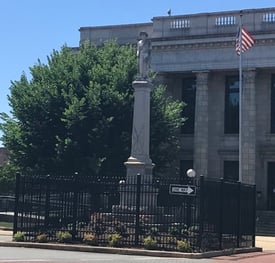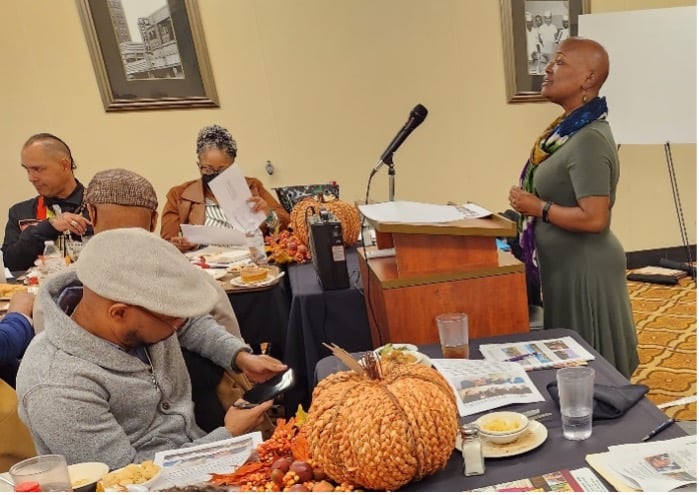I was born and raised in Mebane—a small town in North Carolina that is now primarily white with a large percentage of Black, Indigenous, and Latinx individuals today. My childhood was spent between my father, Jesse’s, side of the family in the West End Community of Mebane and the Hawfields community of dairy farms where most of my mother, Mary’s, side of the family lived. My father worked on dairy farms after his left arm was cut off in a Mebane sawmill accident, while my mother worked in textile mills that caused carpal tunnel syndrome and mini-strokes. Outhouse toilets were the norm during our early years.
I attended Mebane’s segregated West End Elementary School from 1956 to 1964 with Black, Indigenous, and mixed-race students. From 1964 to 1968, I attended the newly constructed, segregated Center High School in Graham, North Carolina, where a Confederate monument stood in front of the county courthouse. I met my wife Brenda Crosby (from Philadelphia) while in undergraduate school at Shaw University in Raleigh, North Carolina. We were then both recruited on full scholarships to help integrate the graduate school program at Bowling Green State University in Ohio.
In 1987, we returned to Mebane to raise our three sons. I worked as a certified insurance broker, selling health and life insurance to Black and Brown folks in Mebane, while Brenda taught elementary children with disabilities in Orange County, North Carolina. As a boy who grew up in the Mebane area and now as a busy insurance broker, many Mebane residents would approach me with issues, like “My yard is underwater from a recent rainstorm, and now there’s sewage backing up on my lawn from a failed septic tank.”
And other times, questions like, “My road has never been paved, and we have dust and stormwater problems with no ditches. Can you help to get our roads paved?” At the time, Brenda and I served as the primary caretakers for both sets of our parents, while also raising our three sons… we weren’t looking for additional responsibilities. Yet, folks were asking, “Can you help solve some of this stuff?”
The elderly individuals in Mebane said to me, “We’ve been living like this for way too long. The city doesn’t listen to us.” As a child, I saw these conditions as a way of life. But as an adult, I looked at it with a different eye. So finally, I said YES. It’s with that that my wife Brenda, cousin Marilyn Holt-Snipes, neighbors, and I co-founded the West End Revitalization Association (WERA) in 1994. To understand the systemic racism that WERA continues to fight against in Mebane today, it’s important to consider our history [the following is reprinted from the WERA website with our permission]:
In 1870, during the aftermath of the Civil War, a man named Wyatt Outlaw became the first Black appointed official in Alamance County. He was appointed by Governor William W. Holden who was also born in Alamance. Unfortunately, his tenure as an appointed official was short because on the night of February 26, 1870, a local chapter of the Ku Klux Klan lynched Outlaw. Outlaw’s murder and other high-profile lynchings motivated Governor Holden to form a small army. The army was led by a former Union Army colonel named George Washington Kirk. This conflict has been historically referred to as “The Kirk-Holden War.” Skirmishes ensued in nearby Caswell and Chatham Counties, and eventually white outrage reached such a fever pitch that Governor Holden was impeached and forced out of office. He remains the only state governor in American history to be successfully impeached and removed from office. The legacy of these events can still be felt in Alamance County today since a Confederate monument stands in front of the county courthouse in Graham, watching over all those who walk up the courthouse steps.
 The Graham Courthouse Confederate monument was erected in 1914 and is a symbol of white supremacy and terror. The $32,000 fence surrounding the monument was erected in 2020 after a wave of anti-monument protests. The fence serves to prolong this monument’s hateful legacy. |
Flash forward to 1994, Omega and Brenda Wilson, along with other community members, co-found the West End Revitalization Association. They looked around their home of the West End Community and saw a place that was ailing from lack of public amenities and being threatened with demolition from the North Carolina Department of Transportation (NCDOT). The 119 bypass and interstate project, a planned eight lane interstate corridor, was projected to plow through West End and White Level, leaving homes, churches, and cemeteries destroyed and dozens of homeowners displaced. In 1999, WERA submitted a federal complaint under Title VI of the Civil Rights Act of 1964 and in reference to the Environmental Justice Executive Order of 1994 to the U.S. Department of Justice (DOJ). The DOJ then directed six branches of the federal government to investigate the city of Mebane’s lack of oversight regarding civil rights and public health guidelines during the highway planning process that had been going on for 16 years without public input. For the next 17 years, from 1999 - 2016, highway construction was placed on moratorium. In response to WERA’s DOJ complaint, the planned 119 bypass corridor was modified to save dozens of homes, a 200-year-old community cemetery, and a historic African American house of worship, Mebane First Presbyterian Church. This church had its first cornerstone laid right after slavery ended in 1865. Unfortunately, WERA was not able to save the original site of St. Luke’s Christian Church, which had an original cornerstone that was laid in 1893.
After WERA’s 1999 DOJ complaint was filed, WERA submitted other complaints that addressed issues under the Safe Drinking Water Act, Clean Water Act, Clean Air Act, and Resource Conservation and Recovery Act. The dual purpose of these other complaints was to combat environmental injustices as a whole and to insure Black, Indigenous, and Latinx residents in Alamance County and Orange County receive the basic amenities for which their tax dollars already pay. Basic amenities, also known as public health infrastructure, can be thought of as everything you get when you check into a hotel room (e.g., safe drinking water, safe and efficient sewer, and an affordable roof over your head), in addition to other common necessities like paved roads and sidewalks. The reason behind this lack of basic amenities can be attributed to institutional racism, something the DOJ referred to as “revisionism.” Instead of allocating money towards the extension of sewer lines in communities of color, which have existed in tandem with the city for generations, Mebane continually gives money, at the expense of tax-paying residents, to wealthy corporations like Walmart and Lidl. With these tax-funded incentives, giant corporations build large facilities. These facilities bring new jobs. However, their planning and construction often create disparities for communities of color, which have existed for 150 years.
Due to WERA’s activism, more than 100 of 500 homeowners have since had sewer lines installed for the first time and dirt streets paved with the support of federally funded community development block grants. Currently, similar injustices still occur. For example, the Mill Creek Golf & Country Club, a haven for white and affluent residents, threatens to engulf White Level and displace its predominantly Black population. City sewer and water lines still are not available to some Black, Indigenous, and Latinx residents of the historic community of White Level, despite many cases of water and sewer lines existing in the adjacent Mill Creek community. Similarly, Spectrum, the corporation which controls broadband internet access, regularly denies White Level residents internet access, despite broadband lines existing across the street in the same area. Finally, a variety of industrial facilities, which all exist in close proximity to communities of color, emit diesel exhaust and other dangerous chemicals into the air, ground, and water.
Amidst the COVID-19 pandemic, WERA has continued its critical work. For example, healthcare waste is largely disposed of in poorer communities, which disproportionately impacts communities of color. This was magnified during the pandemic, as healthcare provision necessitated an exponential increase in the use of personal protective equipment (PPE). Disposal and incineration in landfills results in hazardous air emissions, which pollutes the air our communities breathe and the water we drink. Yet, despite this exponentially increased healthcare waste, the Coronavirus Aid, Relief, and Economic Security (CARES) Act never addressed this. Thus, in partnership with public health and environmental justice advocates from across the country, we passed the “Advancing Environmental Health and Justice: A Call for Assessment and Oversight of Healthcare Waste” policy at the American Public Health Association (APHA) House of Delegates in November 2022. This policy makes recommendations to state and federal lawmakers, the U.S. Environmental Protection Agency (EPA), Joint Commission, and scholars engaged in environmental research. The final action step in this policy reinforces that:
Reduction of healthcare waste and increased tracking alone will not fully eliminate the longstanding burden of waste (healthcare and otherwise) on low-income communities and communities of color in the United States. Federal initiatives designed to address environmental racism, such as Justice40, must prioritize funding towards mitigation of cumulative exposures and impacts moving forward, reparation for harms, and investment in amenities to support well-being for communities fenceline to various waste management practices.
WERA can recognize some successes that reduce barriers to health disparities for people of color and low wealth communities in the Mebane area, including:
- Relocation of the 119 bypass that saved more than 70 homes, two churches, and a 200-year-old cemetery;
- Connecting dead-end residential streets to support a faster response of first responders during emergencies;
- Achieving the City of Mebane’s support of mapping environmental justice communities in Alamance and Orange Counties; and
- WERA’s contribution to a chapter on environmental justice for the county health assessment report for the Alamance County Health Department.
In 2022, this focus on health disparities in Alamance County with an environmental justice lens is being used as a model for all 100 counties in North Carolina, with the support of Governor Roy Cooper’s Health & Human Services staff.
The West End Revitalization Association will continue to stand up against structural racism in Mebane, throughout the state of North Carolina, and across the country. We’ll continue to fight so that all communities of color have the right to basic public health amenities.
**Feature photo (and Confederate monument photo) provided and used with permission from authors Omega & Brenda Wilson and the West End Revitalization Association (WERA). The feature photo pictures the WERA Annual Dinner on November 18, 2022, where Dr. Arlinda Ellison of the Alamance County Health Department speaks to how "environmental justice mapping" brings a sharper focus on health disparities for people of color communities when conducting health assessments.
Interested in other articles like this? Subscribe to our monthly newsletter

|
Omega and Brenda Wilson are Co-Founders of theWest End Revitalization Association (WERA) in Mebane, North Carolina. WERA's mission is to support access to basic public health amenities (e.g., safe drinking water, sewer lines, housing, streets, sidewalks, and stormwater management) for primarily African American and Native American heritage communities in the West End, White Level, Kimrey Road / Hawfields in Alamance County, Buckhorn, Perry Hill, and Cheeks Cross in Orange County. In the April 2019 AARP Bulletin, Brenda and Omega are featured as "Senior Citizen - Citizen Scientists" for collaborative problem-solving that "addresses human beings in their environment." Together, they have received numerous honors, including the Florenza Moore Award from North Carolina Environmental Justice Network (2002), U.S. Environmental Protection Agency (EPA) Environmental Justice Achievement Award (2008), Alamance County - NAACP Environmental & Social Justice Award (2016), and the American Public Health Association's Environmental Section Damu Smith Award (2021). |
- Share
-
Permalink


